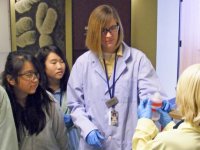Focus on Audience for Better PBL Results
At the end of a project-based learning (PBL) experience, students typically share what they have learned or discovered with an audience. Depending on the project, students might publish their work online, make presentations at a public event, or pitch their ideas to a panel of judges.
For veteran PBL teacher Don Wettrick, "nothing is better than a project that gets community buy-in." Connecting students with an authentic audience is key, he says, to driving engagement and helping students relate what they are learning to the real world. "My top two goals are to help students find great opportunities [for real-world problem solving], and then cheerlead them to a great audience."
From Social Media to the Mayor
Audience interactions might unfold on YouTube or Twitter, where Wettrick (@DonWettrick)helps students "navigate social media and build their digital brand." Face-to-face interactions are equally important. It's not unusual for Wettrick's high school students to make recommendations to the mayor of their Indiana community. "There's no more authentic audience than the mayor," Wettrick says, "when it comes to getting things done."
Wettrick is one of several "expert educators" who will represent the United States next month at the Microsoft Partners in Learning Global Forum in Barcelona, Spain. He will be sharing highlights of projects that his students have tackled in a 21st-century learning class called Innovations. (Until this month, Wettrick taught the class at Franklin Community High School. He recently took a new position as Director of Innovations at Noblesville High School, also in Indiana.)
The Innovations class is deliberately open-ended, which means students have to propose their own project ideas and the standards they plan to meet. They also have to identify subject-area mentors who are willing to work with them. Wettrick has taught English and broadcasting, but knows that projects may go in directions outside his areas of expertise. That's where mentors are key.
"The mentor can't be their dad or their dad's buddy," Wettrick says. "It has to be an expert in an arena, and it has to be somebody who makes a commitment to help them." The right mentor often helps to connect students with an authentic audience. "The people in that mentor's network are going to be your stakeholders," he says.
Some projects go viral, reaching audiences that neither teacher nor students could have imagined. That was the case for an unusual project in which an Innovations student designed a weight-loss and self-confidence building program for a seriously obese classmate. The Indianapolis Star picked up on The Eric Project, which has transformed the life of a student who weighed more than 500 pounds.
Students benefit from honest critique along with positive attention for their projects, Wettrick says. "They don't need to hear, 'Good job!' They're better off when an expert tells them, 'That's not bad, but have you considered this, or you might want to look at that.' Oh, boy," he adds. "When a student gets that kind of response from an expert in a field, that's authentic."
Students aren't the only ones who benefit from an authentic audience. Wettrick encourages teachers to make their good ideas public so that others in education can learn from their examples. "It's not bragging," he says. "It's sharing best practices."
Think Critically About Audience
By thinking more critically about audience interactions, you can make the most of the final phase of PBL. The Buck Institute for Education has produced a feedback form to help audience members think through their role.
Here are three questions to consider as you plan culminating events:
What do you want students to gain from the audience interaction?
- If it's technical feedback, think about inviting experts for a pitch session or judging panel
- If it's response or action, think about having students make presentations to a community group or decision-making body (such as a school board, city council, or neighborhood association)
- If it's a celebration, think about inviting community members whose talents or contributions are being honored or recognized in student projects
Who's the audience for the "real-world" version?
- If students are producing documentaries, plan a red carpet screening event
- If students are making sense of history, set up a museum-style exhibition
- If students are producing literature, plan a book release party, author chat, or poetry slam
How can technology connect students with larger audiences?
Extend your reach to audiences beyond your immediate community by taking advantage of digital publishing sites like YouTube, social media tools like Twitter, or services like #comments4kids to solicit comments for students' blogs.
Many of Wettrick's students, for example, publish their project videos on YouTube. "I grade their work, but they're watching for number of views and community feedback," he says. "When a student gets 2,000 hits on YouTube, that's meaningful."
How have you connected your students with authentic audiences? How did the interactions lead to deeper learning? Please share your thoughts in the comments.
